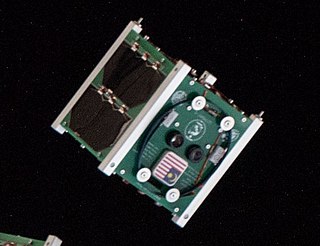
A small satellite, miniaturized satellite, or smallsat is a satellite of low mass and size, usually under 1,200 kg (2,600 lb). While all such satellites can be referred to as "small", different classifications are used to categorize them based on mass. Satellites can be built small to reduce the large economic cost of launch vehicles and the costs associated with construction. Miniature satellites, especially in large numbers, may be more useful than fewer, larger ones for some purposes – for example, gathering of scientific data and radio relay. Technical challenges in the construction of small satellites may include the lack of sufficient power storage or of room for a propulsion system.

The space program of the Philippines is currently maintained by the Philippine Space Agency (PhilSA) together with various agencies under the Department of Science and Technology (DOST). The space program includes space research and development, and is funded through the National SPACE Development Program (NSDP) by the DOST and received an initial budget of ₱1 billion in 2020.

The Philippine Space Agency (PhilSA) is the national space agency of the Philippines.

Diwata-1 also known as PHL-Microsat-1 was a Philippine microsatellite launched to the International Space Station (ISS) on March 23, 2016, and was deployed into orbit from the ISS on April 27, 2016. It was the first Philippine microsatellite and the first satellite built and designed by Filipinos. It was followed by Diwata-2, launched in 2018.

The Philippine Earth Data Resource and Observation Center, also known as the PEDRO Center is an organization tasked in operating satellite ground stations.

Diwata-2 or Diwata-2B is a Philippine microsatellite launched on October 29, 2018. It is the first satellite launched under the STAMINA4Space program.

BRAC Onnesha was the first nanosatellite built in Bangladesh to be launched into space. The satellite was designed and built in conjunction with Kyushu Institute of Technology Birds-1 program, which has the goal of helping countries build their first satellite. It was designed and built over a two-year period.

Birds-1 was the first iteration of a multinational program called the Joint Global Multi-Nations Birds Satellite project, or Birds project, to help countries build their first satellite. The Japanese Kyushu Institute of Technology (KIT) supported the design and fabrication of the satellites. The constellation was launched by a Falcon 9 rocket to the International Space Station on 3 June 2017, as part of CRS-11, where it was released from the Kibō module into space. Japan, Ghana, Mongolia, Nigeria, and Bangladesh participated in the Birds-1 program, all building identical satellites for the constellation.

Maya-1 was a Filipino nanosatellite. It was developed under the Philippine Scientific Earth Observation Microsatellite program (PHL-Microsat) and was jointly implemented by the University of the Philippines and the Department of Science and Technology as part of the Kyushu Institute of Technology-led multinational second Joint Global Multi-nations Birds Satellite (Birds-2). Maya-1 was the first nanosatellite of the Philippines.

BHUTAN-1 was the first Bhutanese nanosatellite to be launched into space. The satellite was built during Kyushu Institute of Technology's Birds-2 program. The Birds program helps countries fly their first satellite. BHUTAN-1 was launched into orbit aboard the SpaceX CRS-15 mission on 29 June 2018. It was deployed from the Kibō module of the International Space Station (ISS) on 10 August 2018. The satellite had cameras to image the Earth.
The Space Technology and Applications Mastery, Innovation and Advancement is a space technology program by the Philippine government. It is considered as the successor program to the Philippine Scientific Earth Observation Microsatellite (PHL-Microsat) program, a cooperation between the Philippine government and Japanese universities to develop microsatellites. The program is funded under the Department of Science and Technology.

UiTMSAT-1 was a Malaysian nanosatellite, built primarily by Universiti Teknologi MARA (UiTM) as part of the multi-nation Birds-2 project. The 1U CubeSat was launched into space on 29 June 2018 and deployed from the International Space Station (ISS) on 10 August 2018.
Birds-2 is the second iteration of a multinational program called the Joint Global Multi-Nations Birds Satellite project, or Birds project, to help countries build their first satellite. The Japanese Kyushu Institute of Technology (KIT) supported the design and fabrication of the satellites. The satellites were launched by the Falcon 9 Full Thrust rocket as a part of the SpaceX CRS-15 mission on 29 June 2018. The satellites were released from the Kibō module of the International Space Station (ISS) in August 2018.
The Innovative Satellite Technology Demonstration Program is a series of spacecraft missions for testing technology and ideas put forward by universities and private companies. The program demonstrates various experimental devices and technology in space by providing flight opportunities. It is managed by the JAXA Research and Development Directorate. According to JAXA, the goal of this program is to test high risk, innovative technology that will lead to the space industry gaining competitiveness in the international field.
The University Laboratory for Small Satellites and Space Engineering Systems (abbreviated and stylized as ULyS3ES) is a space research complex of two buildings.

Joel Joseph Sacro Marciano Jr. is a Filipino engineer, academic and the first and current Director General of the Philippine Space Agency, a government agency under the Office of the President in charge of the Philippines' national space program.
Maya-2 was a Filipino nanosatellite. It succeeded Maya-1, the first Filipino nanosatellite, which was deorbited in November 2020.
The Multispectral Unit for Land Assessment (MULA) is a planned Filipino satellite. Upon completion it will become the largest Filipino-made satellite.















